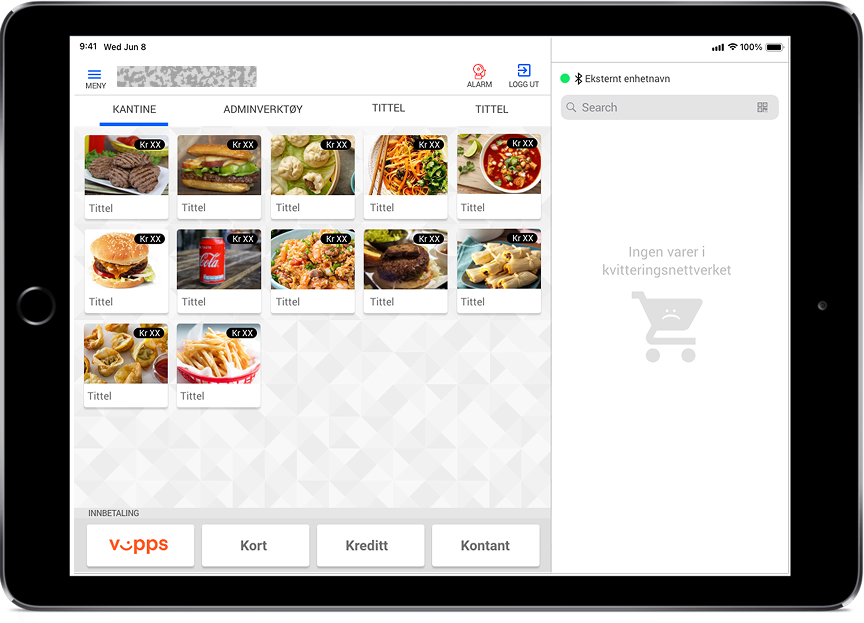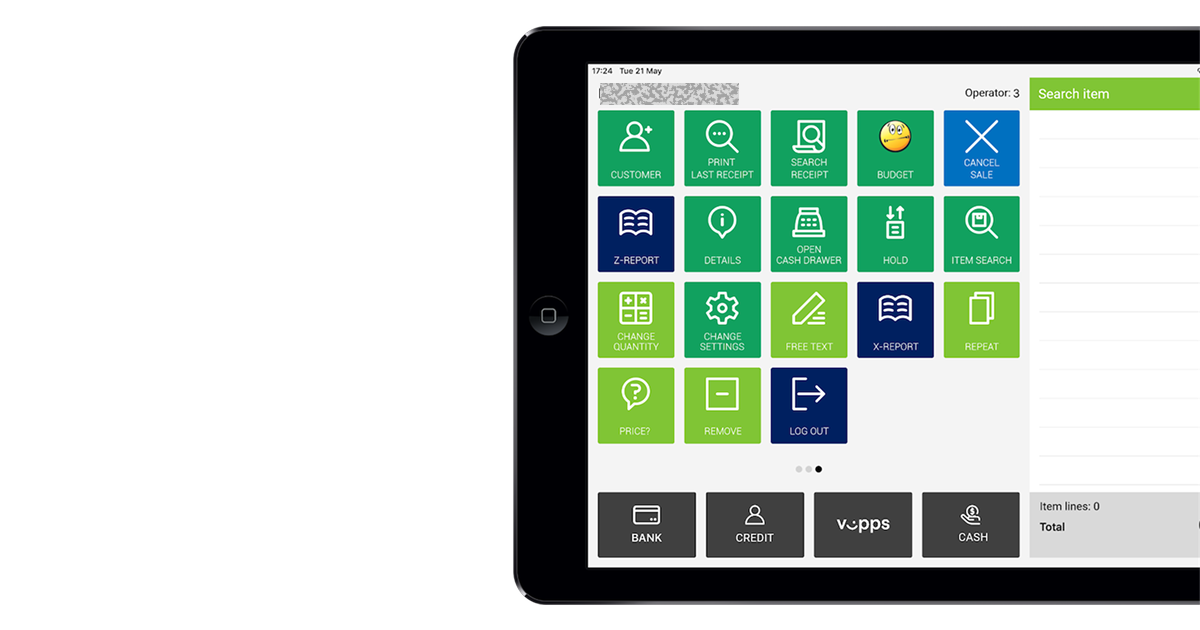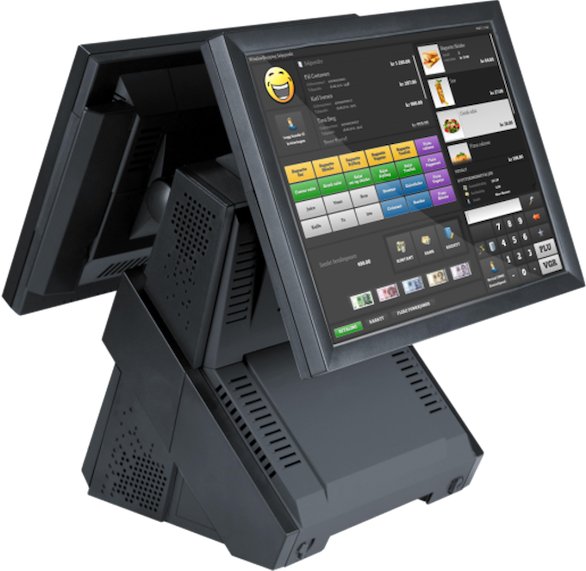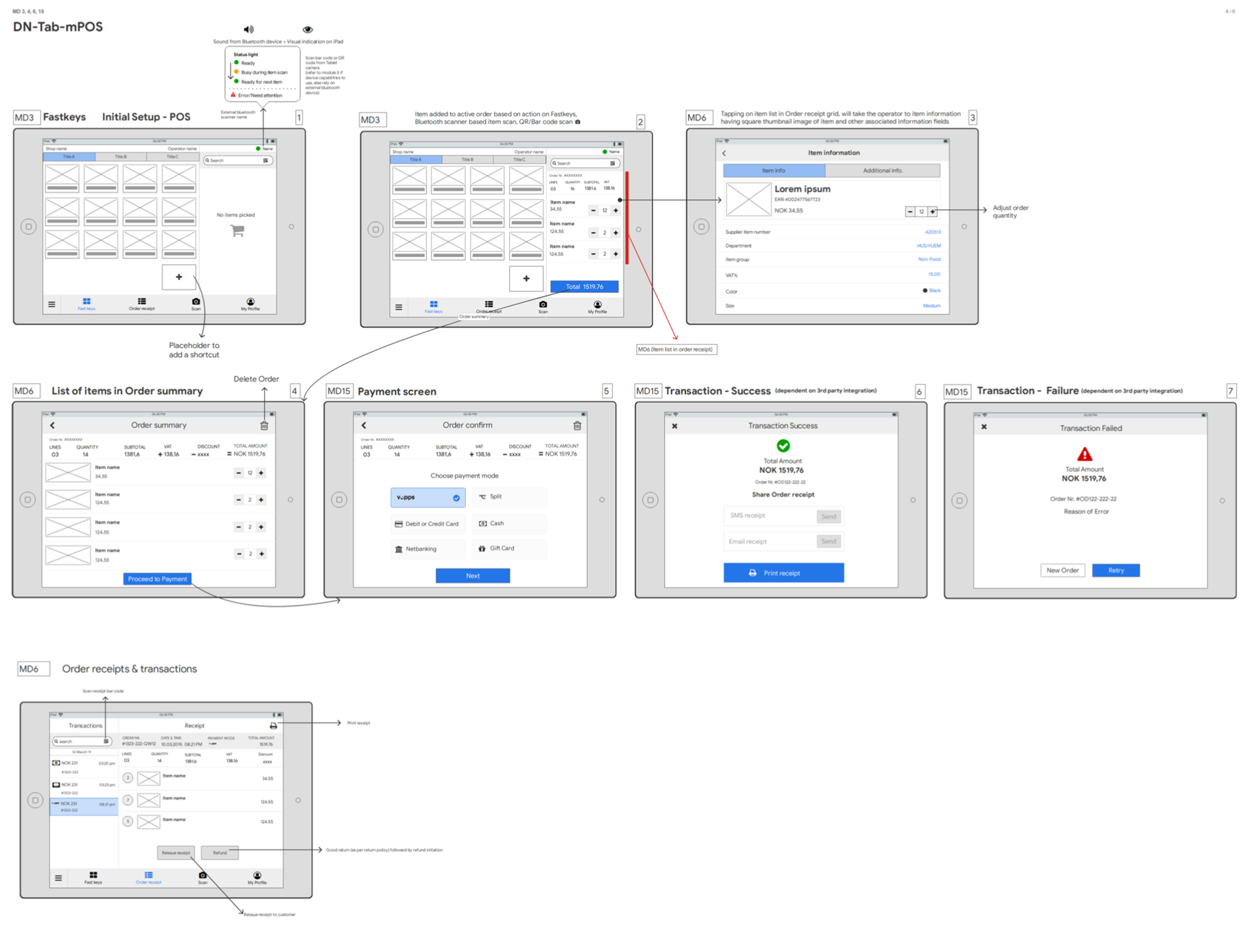Scalable Mobile POS for European Retail
Sleeker leaner and flexible POS system for cross verticals
🧭 Overview
This case study outlines the end-to-end UX design process for transforming a legacy Windows-based Point of Sale (POS) system into a scalable, cross-platform POS platform for a European retail service provider.
The redesign aimed to improve speed, usability, and scalability, aligning with modern retail needs while minimizing disruption to ongoing store operations.
Project Context
The client operates across multiple European countries, using a POS system built for desktop-only environments. As the company scaled, the legacy design and architecture began limiting flexibility and speed.
The leadership sought a modern, cloud-ready POS that could unify operations, reduce errors, and support multiple devices (desktop, tablet, and mobile terminals).
🎯 Objective
The objective of this project was to design and develop a platform-agnostic Point of Sale (POS) application that operates seamlessly across Android and iOS devices.
The app was intended to complement existing retail systems rather than replace them — providing a lightweight, mobile POS interface that could be used for quick transactions, queue management, and customer processing in flexible retail environments.
Key objectives included:
- Reduces transaction time and training effort
- Supports scalability across devices and geographies
- Enables modular integration for third-party APIs
- Improves overall user satisfaction and operational efficiency
- Can be scaled to cross verticals with minimal changes to codebase with top level customization
👤 My Role
Role: UX Designer
Scope: Handled all UX activities from research to launch, including:
- User research & persona creation
- Journey mapping & information architecture
- Wireframing, prototyping, and design system creation
- Usability testing & iterative refinements
- Collaborated with development and product teams for rollout & the public launch
🕒 Timeline
Total Duration: 18 Months
| Phase | Duration | Key Activities |
|---|---|---|
| Discovery & Research | 2 months | User interviews, contextual inquiry, and competitor benchmarking |
| Information Architecture & UX Strategy | 2 months | Journey mapping, user flow definition, architecture alignment |
| Design & Prototyping | 7 months | Wireframes, design system creation, visual design, and iterative refinements |
| Usability Testing & Refinement | 3 months | Multi-vertical user testing, accessibility validation, and design optimization |
| UAT & Design QA | 3 months | End-user acceptance testing, feedback cycles, and design–development alignment |
| Launch & Evaluation | 1 month | Post-launch analytics review, user adoption measurement, and iteration roadmap |
🧩 The Challenge
The Windows-based POS was functional but outdated as it required technology upgrade to scale the interaction across multi-device.
Core challenges:
- Legacy UI constrained scalability
- Steep learning curve for new employees
- Inconsistent workflows across regions
- Limited support for mobile or tablet use
- No cloud based support
Key Question:
How might we modernize the POS experience and architecture while maintaining reliability and minimizing staff re-training?
🎯 UX Goals
- Unify UI across desktop, tablet, and mobile devices
- Simplify task flows for faster transactions
- Standardize components with a scalable design system
- Improve accessibility across multilingual regions
- Enhance usability for both cashiers and store managers
👥 Understanding Users
Personas
The redesigned POS system served users across multiple retail environments in the Scandinavian region, where efficiency, precision, and reliability are highly valued.
Each role represented a key user segment involved in daily store operations, management, or IT administration.
🧾 Ingrid — Cashier
- Age: 27
- Role: Frontline retail associate
- Goals:
- Complete transactions quickly with minimal steps.
- Manage queues efficiently during peak hours.
- Frustrations:
- Excessive pop-ups and deeply nested options slow down the process.
- Small interface buttons reduce accuracy during quick touch interactions.
- Quote:
“I need large, clear buttons and fewer screens — speed matters most when the queue is long.”
📊 Lars — Store Manager
- Age: 42
- Role: Operations and sales manager
- Goals:
- Monitor live sales and staff performance.
- Simplify reporting and end-of-day reconciliation.
- Frustrations:
- Reports buried under multiple menus.
- Lack of mobile-friendly access to real-time store data.
- Quote:
“If I could review reports and sales summaries on the go, I’d save hours every week.”
🖥️ Emma — IT Administrator
- Age: 36
- Role: IT operations and deployment lead
- Goals:
- Streamline updates and maintain consistent software versions across locations.
- Ensure system uptime, data privacy, and compliance.
- Frustrations:
- Manual installation and maintenance processes.
- Limited flexibility to integrate with local payment and reporting tools.
- Quote:
“The POS should be easy to update remotely — we can’t afford downtime for every patch.”
Key Insights from Personas
- Users value clarity, speed, and predictability in interface behavior.
- Harsh environmental conditions require large touch zones and high contrast design.
- Managers expect mobility and real-time visibility through dashboards.
- IT administrators emphasize remote maintenance and security compliance.
🔍 Research & Insights
Methods
- Contextual inquiries in 3 retail environments
- Stakeholder workshops and interviews
- Competitor benchmarking (Square, Toast, Lightspeed)
- Task frequency mapping for POS interactions
Key Findings
- 80% of daily interactions came from 5 frequent tasks: scan → add → discount → pay → print.
- Users wanted larger touch targets, shorter workflows, and consistent layouts.
- Managers required real-time dashboards to monitor store health.
- IT teams prioritized cloud-ready modularity.
🧠 Strategy
The UX strategy revolved around efficiency, scalability, and adaptability.
Guiding Principles:
- Efficiency: Prioritize speed for frequent actions.
- Scalability: Modular components supporting multi-device use.
- Clarity: Simplified visual hierarchy for fast recognition.
- Accessibility: Large touch areas, color contrast, multilingual UI.
- Architecture Alignment: Design compatible with API-first backend.
🏗️ Information Architecture
Structured the POS into three logical layers:
- Transaction Layer – Core workflows: scan, payment, receipt
- Operations Layer – Shift logs, returns, staff performance
- Analytics Layer – Reports, KPIs, revenue insights
This modular architecture allowed adding features without UI rework.
🎨 Design Evolution
🕰️ Before State (Legacy POS - Desktop)
- Desktop-only layout
- Dense tables and small buttons
- Multi-step transaction process (scan → apply → confirm → pay → print)
- Slow performance and non-adaptive interface
🚀 After State (Redesigned Mobile POS - Tablet)
- Responsive design for desktop and tablet
- Modular, card-based interface
- Streamlined transaction workflow (scan → pay → receipt)
- Real-time dashboard and customizable views
- Accessible color palette and 44px touch targets
Design Process
1️⃣ Wireframes
Low-fidelity sketches were created using Balsamiq for both smartphone and tablet views.
Key Focus Areas:
- Reduced cognitive load through clear hierarchy and large, tappable icons.
- Introduced gesture shortcuts for high-frequency actions.
- Enabled swipe gestures to add or remove items seamlessly.
The wireframes emphasized efficiency — ensuring operators could complete core actions in under three taps.
2️⃣ Visual Explorations
Three visual design directions were explored to balance brand identity, usability, and environmental adaptability:
| Variation | Description |
|---|---|
| A. Light Minimalist Theme | Clean, neutral layout optimized for clarity and speed. |
| B. Rich Contrast | Vibrant retail-focused interface for high-traffic store visibility. |
| C. Simplified Neutral UI | Enterprise-ready design aligned with rebranding efforts. |
 Visual Exploration A: Light Minimalist Theme
Visual Exploration A: Light Minimalist Theme
 Visual Exploration B: Rich Contrast
Visual Exploration B: Rich Contrast
 Visual Exploration C: Simplified Neutral UI
Visual Exploration C: Simplified Neutral UI
A dark theme was also tested to improve eye comfort in prolonged usage environments such as night shifts and low-light kiosks.
User testing revealed a preference for the light minimalist variation due to its visual clarity and reduced strain during extended use.
 Visual Exploration D: Dark theme
Visual Exploration D: Dark theme
3️⃣ Voice Interaction Prototype (VUI)
We explored the concept of Voice-Generated UI Interaction to enhance accessibility and reduce manual navigation for staff handling high transaction volumes.
Concept:
“What if operators could speak commands instead of navigating menus?”
Voice Command Examples:
- “Add item 2456”
- “Apply 10% discount”
- “Print receipt and close order”
This experimental feature demonstrated potential for hands-free interaction, improving accessibility for differently-abled operators and optimizing speed in high-traffic retail settings.
Impact:
Reduced cognitive load, improved readability, and faster checkout time by 32%.
🧪 Prototyping & Testing
Process
- Built interactive prototype covering cashier and manager journeys.
- Conducted usability tests across different customer segments for early feedback
- Measured task completion time, error rate, and satisfaction.
Key Findings
| Issue | Observation | Solution |
|---|---|---|
| Small buttons on touch devices | Frequent misclicks | Enlarged tap zones, adaptive grid layout |
| Overwhelming payment screen | Too many simultaneous actions | Introduced step-by-step payment modal |
| Report discovery | Hard to find shift reports | Added shortcut in dashboard header |
🚀 Launch & Impact
The redesigned POS was successfully deployed across 12 pilot stores in Europe.
Post-launch metrics demonstrated measurable business impact.
| Metric | Before | After | Improvement |
|---|---|---|---|
| Checkout time | 2.8 min | 1.9 min | ⏱️ 32% faster |
| Training duration | 7 days | 3 days | ⏱️ 57% shorter |
| System deployment | Manual | Cloud-based | ☁️ Streamlined |
Business Outcomes
- Faster onboarding for new operators across 100+ retail outlets.
- Reduced maintenance overhead via unified codebase.
- Improved customer service through quicker transactions.
- Foundation for new verticals (restaurants, ticketing, service kiosks).
- Voice accessibility recognized as a breakthrough concept for future expansion.
📈 Key Achievements
- ✅ Unified POS app for Android & iOS
- ✅ 85% faster user onboarding
- ✅ 66% reduction in transaction errors
- ✅ Introduced accessibility-first design mindset
- ✅ Cloud deployment reduced release cycles by 70%
💬 Reflections & Learnings
- Redesigning enterprise systems requires understanding user behavior, not just UI polish.
- Field testing in real environments helped validate real-world efficiency gains.
- Early collaboration with developers was crucial for design–architecture cohesion.
- Voice-first design challenges traditional IA, requiring adaptive states and error recovery.
- Collaboration with local teams in Norway ensured cultural and compliance relevance.
✨ Conclusion
The POS redesign evolved from a legacy desktop interface into a modern, scalable, and user-friendly ecosystem that adapts across devices and regions.
As the UX designer leading all design activities from research to launch, I ensured that every decision connected usability, architecture, and scalability — resulting in faster workflows, happier staff, and a platform ready for future growth.
“Scalability isn’t just a backend challenge — it’s a UX commitment to flexibility and focus.”



